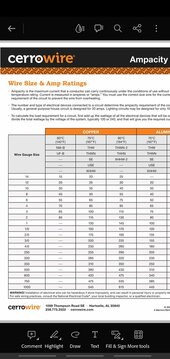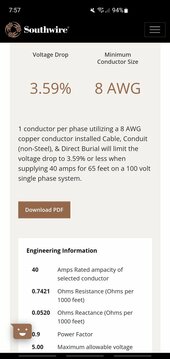DougfromdaUP
Solar Enthusiast
That chart is wrong. It’s for 12 volts.
Go to the south wire (or any other calculator) and run it using the actual voltage.
Go to the south wire (or any other calculator) and run it using the actual voltage.
We are probably using different numbers.i just ran 13.3 amps, 72 volts for a 65 foot circuit using #10 and got 2.5% voltage drop.
Are we talking about the same thing?
Again, that chart is for 12 volt wires exposed in engine rooms. It is useless for anything else.

See, I thought that chart was voltage-agnostic, hence why wiring in series is advantageous because it keeps the current down and allows you to use thinner/cheaper wire.That chart is wrong. It’s for 12 volts.
Go to the south wire (or any other calculator) and run it using the actual voltage.
Many people think that. It’s a shame that that chart is so often replicated without titles clarifying what it is.See, I thought that chart was voltage-agnostic, hence why wiring in series is advantageous because it keeps the current down and allows you to use thinner/cheaper wire.
Correction: The Southwire calc is already figuring twice the length for the circuit vs run length. So enter 65 instead of 130. The voltage drops listed above are overtstated. Thanks @DougfromdaUP .We are probably using different numbers.
We dont have his exact Vmpp where the charge controller will keep that line voltage at. With Voc of 40.3, i would guess its around 32-33v??? So I just use 100v to keep things simple.
Now we have to determine acceptable voltage drop. The OP was using the 10% column as its a non critical system (it really doesn't care if voltage drops). I used 10% in the calculator as well. NEC max is 5% for most circuits but they dont have a max drop for PV because it doesn't pose any hazzard if voltage drops.
NEC does care about Ampacity of the wire as it is the ability to carry the current without overheating, no matter voltage or length.
Ampacity rating of 8awg is 40A.
View attachment 209794
So a run of 8awg will carry 40a with 7% voltage drop.
Same run with 6awg will have 4.6% voltage drop.

I thought we were discussing the runs from the strings to the combiner box, not the home run from combiner box to house?Correction: The Southwire calc is already figuring twice the length for the circuit vs run length. So enter 65 instead of 130. The voltage drops listed above are overtstated. Thanks @DougfromdaUP .
I would still run 8awg in this scenario being the 4 strings combined out at the array could have up to 40A on the run to the house.
View attachment 209864
Ahh i misunderstood it as the 65ft run was with the strings combined. If the OP did 4 separate 65ft runs of 10awg theres nothing to do, its fine. Thats alot of wire... but its fine.I thought we were discussing the runs from the strings to the combiner box, not the home run from combiner box to house?
"Hi all, need some help: my panels are installed on ground mounts between 45-65 feet from my junction box and, like a moron, I made the classic mistake of not doubling the length of my cable runs from the panels to the box when sizing my wires, and need to upgrade from the 10 awg wires I have now. I have four inputs on my junction box, each connected to three 320w/24v panels in series (so roughly 13.3 amps/72v max apiece), and according to my consultation of THE CHART, and accepting a moderate but not horrible voltage drop, 6 awg seems to be the way to go. Only problem is I can't seem to find 50-65 foot 6 awg cables anywhere with the mc4 connectors already on them..."
Yes certainly no need to rip out the existing 10 and put 8 AWG in.Ahh i misunderstood it as the 65ft run was with the strings combined. If the OP did 4 separate 65ft runs of 10awg theres nothing to do, its fine. Thats alot of wire... but its fine.
IndeedYes certainly no need to rip out the existing 10 and put 8 AWG in.


